Autumn, mushrooms and toadstools
Autumn is letting go, trees are dropping their leaves and it is getting colder and darker faster. Nature is going into rest mode and you can smell the sickly scent of the autumn forest. It is going fast now and the leaves are rapidly changing colour into the most beautiful colours and then falling to the ground where they are blown in all directions by the wind and rain. The most beautiful seasons for me are the spring of building up with all those different green colours and the autumn of going to rest with yellow-orange-red-brown colours. They can skip the winter with its cold, short and dark days as far as I am concerned and I prefer to crawl deep into my nest like a hedgehog for a long hibernation. But yes, without winter there is no spring, summer and autumn, so I will have to make do.
While I am writing this story, the rain is beating against the window and reminding me of the beautiful dry and sunny days of the past few weeks. Wonderful those warm days while walking with our dogs Siena & Giulia, my Saskia and friend Emile through the forests of Zeist. If you have dogs you have to go outside and with our hunting dogs I do that at least five times a day. So come rain or shine, here I go again. Boots and raincoat on, hat on and if it is very wet the dogs also wear a raincoat, because I do not need two wet stinking dogs in the house five to seven times a day. Yes, it is raining and the mushrooms are shooting up like mushrooms.
A mushroom quickly emerges from damp forest soil and the expression is used when things come to light quickly and frequently.
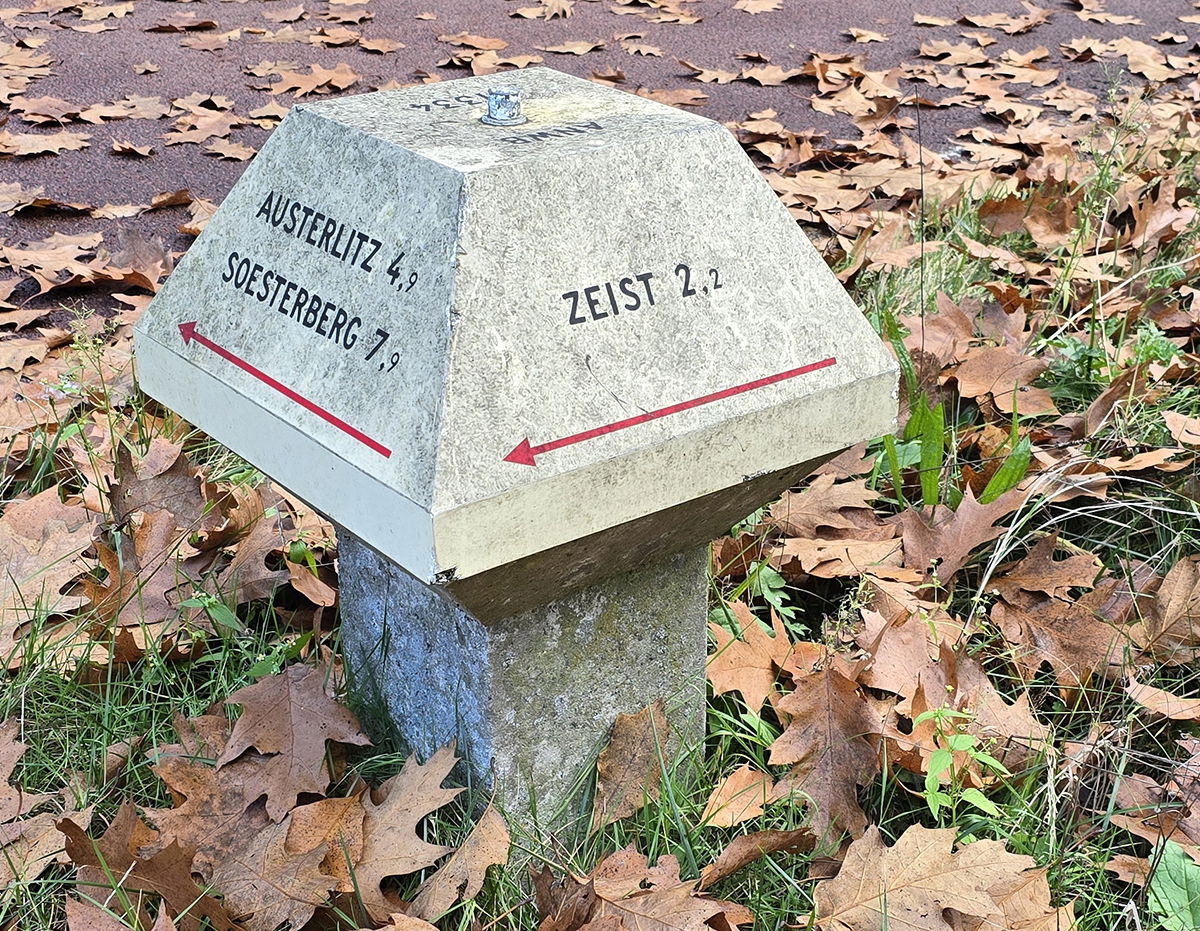
ANWB boletus
Walking to the forest with Siena & Giulia I come across the first mushroom. It is not a real one, but a concrete almost hundred-year-old and 80 kilo ANWB boletus from 1927 with a metal cap, which indicates the direction to Zeist, Austerlitz and Soesterberg. The ANWB board chose the mushroom shape in 1919 because it fitted best in the nature reserves through which recreational cycle paths ran. But just like everything that is transient, this species is also dying out with its original weight of 145 kg of concrete. The 5,000 mushrooms of today have been made of red polyester since 2003 and have been managed by Rijkswaterstaat since 2010. There is quite a bit of confusion about the name mushroom. You probably still know that song from your youth “On a big mushroom Red with white dots. Gnome Spillebeen Was rocking back and forth, Crack, said the mushroom Then with a deep sigh, Both legs Hoepla in the air”. I hear you thinking, but isn’t that a Fly Agaric? That’s right, and that’s very confusing, but I’ll explain it to you below.
Origin of the name mushroom
The name “mushroom” itself is a reminder of the thirteenth and fourteenth centuries, when mushrooms and other ‘poisonous’ plants were considered to belong to the realm of the devil and his henchmen – witches, wizards and toads who sat on the mushroom.
Volunteers from the Utrechts Landschap told me that they had seen with their own eyes a number of times that toads walked to a mushroom and sat on it. So not a fable and not a gnome Spillebeen as in the song, but a toad.
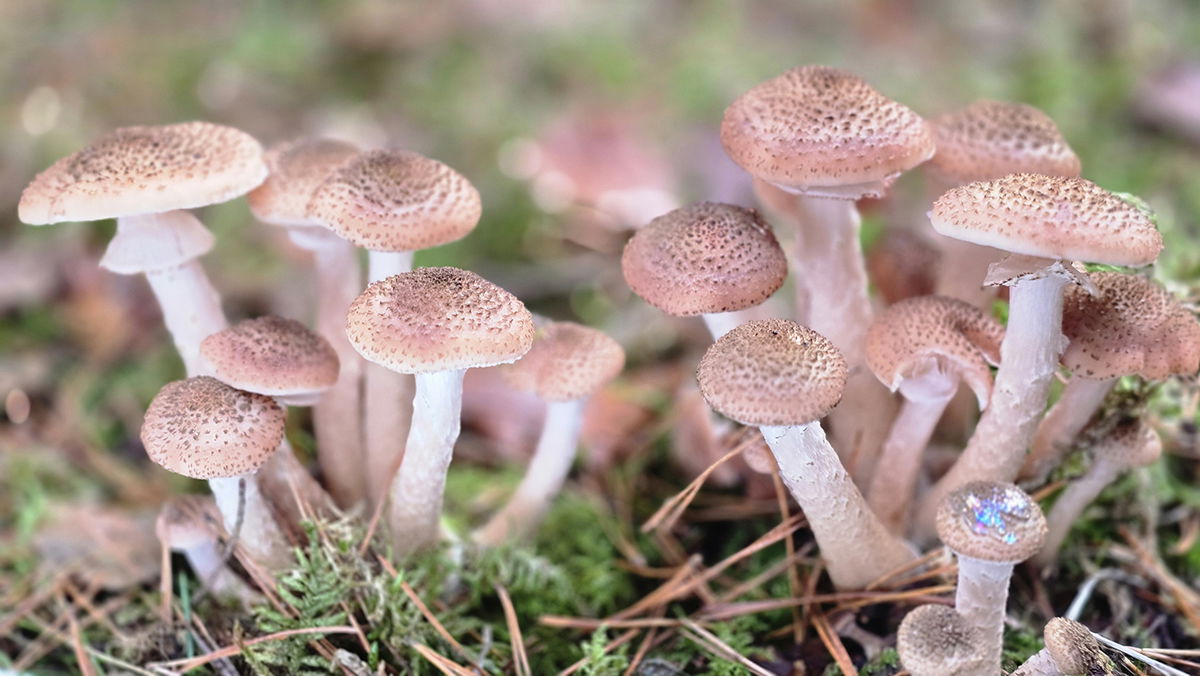
Gloomy honey fungus
A mushroom is the fruiting body of an underground fungal network
A fungus consists of a whole network of thin fungal threads underground or in wood called hyphae. Together, these hyphae form a kind of web called mycelium. The mycelium secretes digestive enzymes that dissolve the food in the immediate vicinity, so that it can be absorbed.
The fungus makes a fruiting body: the mushroom. The purpose of a mushroom is to produce and spread spores. Under the cap of the mushroom is the hymenium or germinal membrane. The spores are formed on this germinal membrane. What this looks like differs per mushroom. Some mushrooms have gills under the cap, others have plates, pores or spines. Only the fruit sticks its head above the ground. The cap of the mushroom provides protection for the spores against the elements. In young mushrooms, there is also a membrane over the spores. When the mushroom ripens, this membrane tears open and the spores are released. When they are released, they are carried away by the wind, by water or by animals. In this way, they provide new fungi and eventually new mushrooms. On the cap of the mushroom lie flakes that are the remains of the membrane of the fungus from which the mushroom has sprung.

Common Sulphur Fungus
Elf benches
And what about elf benches? They don't look like mushrooms at all. No, but they are just mushrooms, or the fruiting body of a fungus. They grow on dead wood, for example, and the fungus is under the surface of that wood.
Antibiotics
Soil fungi are a natural source for making medicines. For example, the brush fungus can make penicillin, which is an antibiotic that fights harmful bacteria in the body.
Cleaners in nature Together with bacteria and soil fungi, mushrooms are responsible for biological decomposition and are absolutely indispensable in our nature. With their fungal threads they clean up organic material, such as leaves, wood and dead worms. Mushrooms are a kind of vacuum cleaner! More than 90% of the decomposition of organic waste is done by fungi. Without them, a forest would
die in its own waste. But soil fungi also convert organic material into food for plants and other soil organisms. There are also fungi that work together with trees and that is why some trees only grow near these soil fungi. The fungus transports minerals and water from the soil to the tree roots, in exchange for carbon and energy. In addition, soil fungi also have an anti-erosion function. With their sticky threads they hold soil particles together and in this way they ensure that during heavy rainfall, the soil stays in place and does not simply wash away.
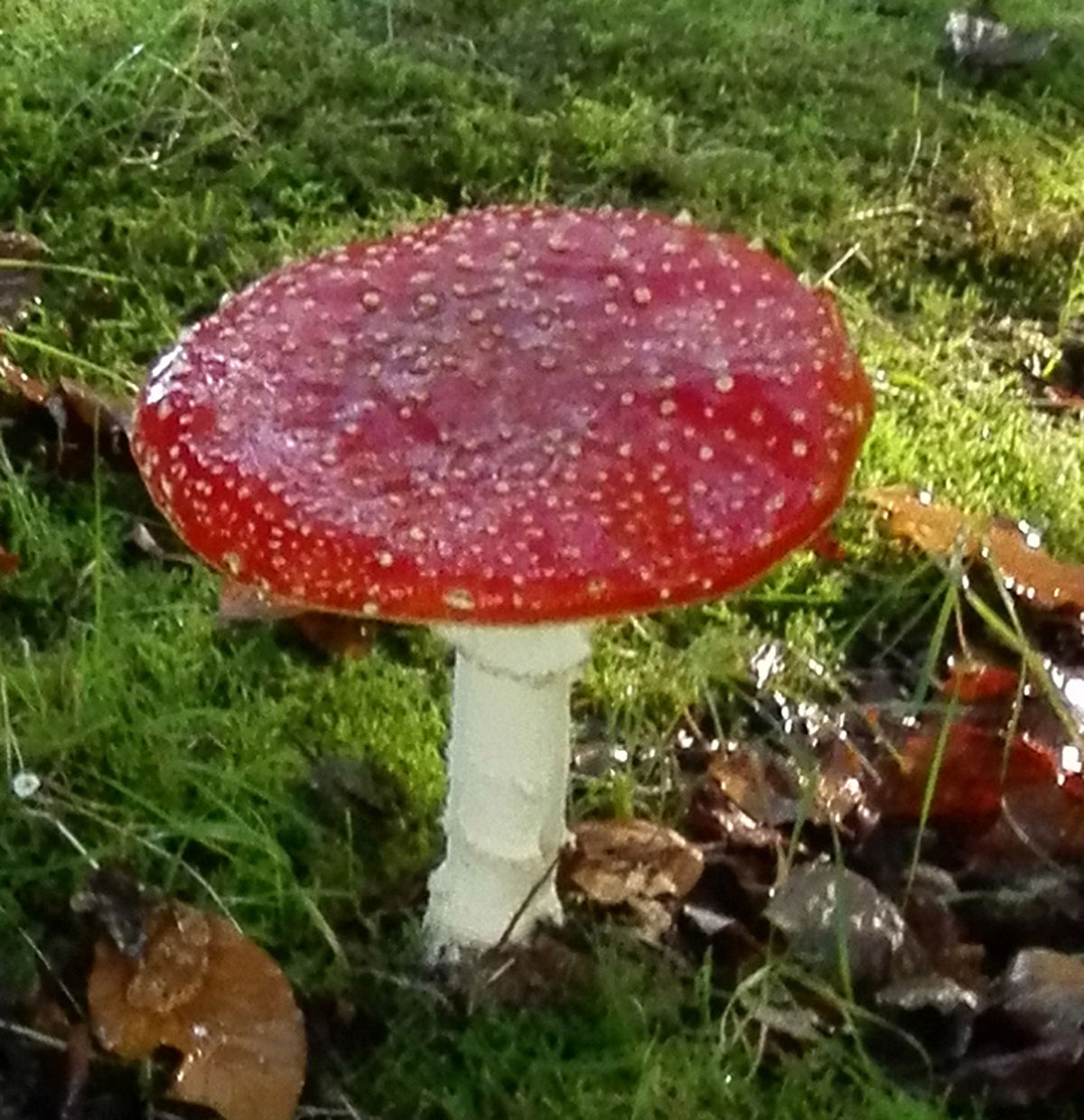
Fly agaric
Fungi and mold
Fungi and mold are about the same (synonyms). A fungus is a fungus and a mold is a fungus. The scientific name for both is Fungi. They are organisms that consist of cells with a nucleus, mitochondria (energy factory of a cell), cell wall and a cytoskeleton (cell).
The expression “don't talk like that” refers to chatting or talking and is derived from the fungus as a spongy, rotten plant without substance that very quickly emerges and grows large and then collapses again. Completely identical to whining conversations, to empty talk or chatter in space.
The 3 most important types of fungi
1. the agaric (for example the Fly Agaric) stores its spores on the gills in its cap
2. the tube fungus (for example the Sulphur fungus) stores its spores in very small tubes and lets them fall out
3. the stomach fungus or puffball (for example the Yellow potato puffball) has no visible stem or cap and forms spores in the 'belly' of the mushroom. When the spores have to be spread, the fungus bursts open.
A nasty fact
Some fungi smell like sperm and certainly when fungi rot they secrete a very foul smelling odor.
How did the Fly Agaric get its name?
The favorite mushroom is the extremely poisonous Fly Agaric (Amanita muscaira) with a cap that can grow up to 20 centimeters wide and is usually bright red, later the cap fades to orange/yellow. The cap has the characteristic "white dots", which are pyramid-shaped, poisonous flakes. These flakes easily wash off the cap during a rain shower and that is why you sometimes see Fly Agarics without white dots.
These flakes used to have a function in agriculture. Farmers mixed the poisonous flakes with milk or water and placed that mixture in the stable to get rid of the flies. This is how the Fly Agaric got its name. Like all other mushrooms, the Fly Agaric likes moisture. In dry autumn periods you will therefore encounter few Fly Agarics..
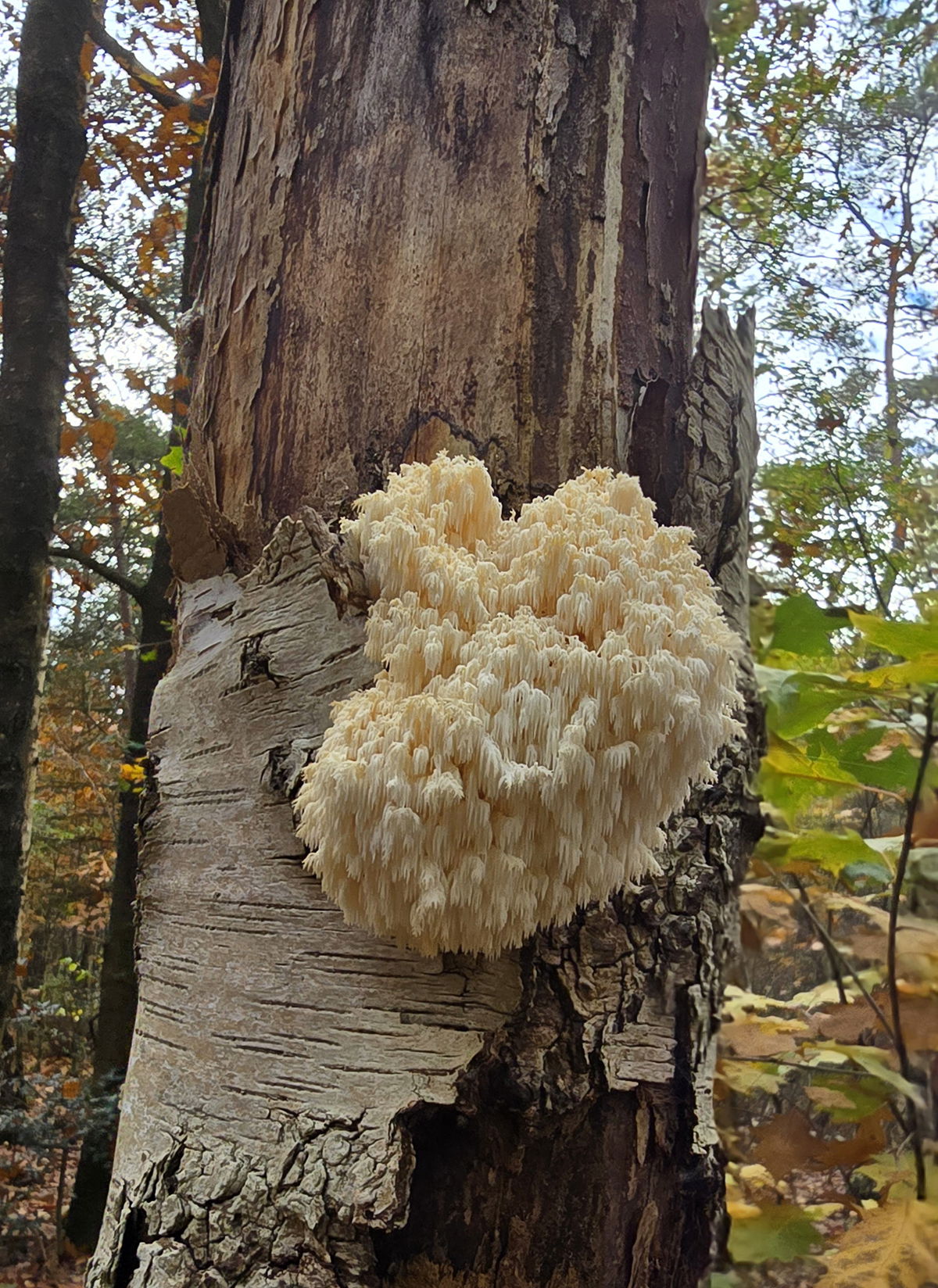
Hericium coralloides
Rare Crested Thrush
Sherall, a volunteer at Utrechts Landschap, discovered the rare Hericium coralloides (Hericium coralloides) on the Heidestein estate. Last Saturday, October 26, she provided a very educational and interesting mushroom excursion for a group of 15 people in which I participated, which I can highly recommend. From a distance, the Hericium coralloides look like round balls, but up close you can see that they consist of hanging and row-shaped spines that look like white coral. The Hericium coralloides does great in places where there is a lot of “humus-rich soil” and where old beech trees grow.
Mystery of the fairy ring
Walking along the sandy road Hoog Kanje towards Austerlitz, I saw this enormous fairy ring of the Nevelzwam (Clitocybe nebularis). In the old days, when the origin of witches' circles was still a mystery, their appearance was explained in the devilish or mythical sphere. Witches, devils or elves let them grow. They appeared where witches performed their nightly circle dance, regularly sniffing and leaving the snot they spat out on the ground as Witches' Butter. Or it was a scorch mark from the flames or the hot breath of a fire-breathing dragon. Woe betide anyone who stepped into the circle at full moon or let his cow graze within the circle!
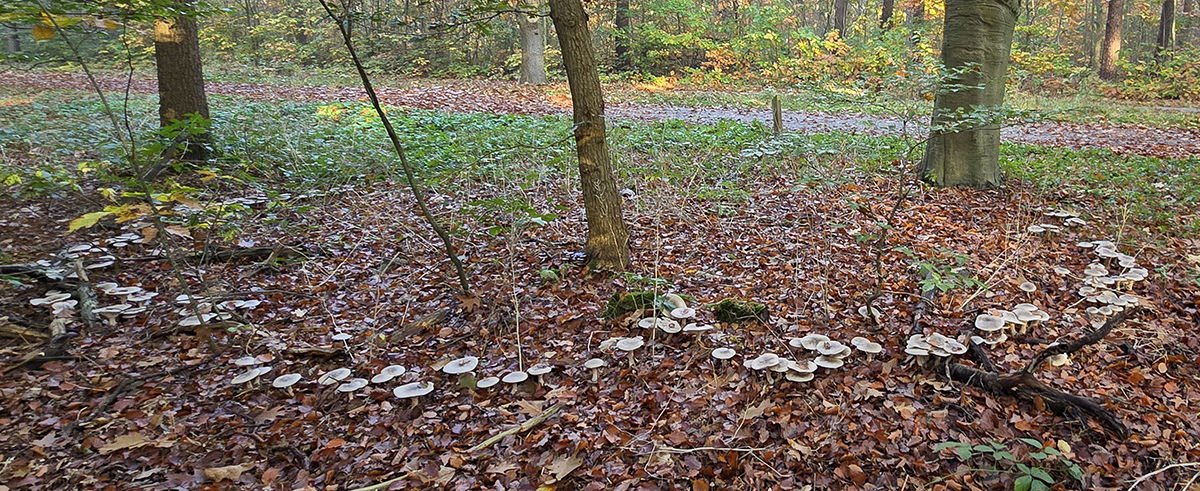
Witches' Circle Sulphur fungus
Thanks in part to the purchase, protection, restoration and management of forests and estates by the Utrechts Landschap and all those volunteers, we can continue to enjoy all this beauty now and in the future.
In the gallery of the website you can see what an enormous variety of fungi and toadstools I have photographed in the forests of Heidestein, De Breul and Molenbosch and I am sure that these are not all the species that can be found in the Netherlands.
One even more beautiful and whimsical than the other and all very special. When I walk through the forest I look around me completely differently because of all this beauty.
He who does not look, does not see. He who does not read, does not know.
How beautiful Zeist is and how lucky we are to live here.
Until the next walk around Castle Kerckebosch, Arnie Della Rosa
You can read my walking stories at https://www.als-bomen-en-stenen-konden-praten.com but also together with the columns of other Zeister columnists at https://www.zeistermagazine.nl